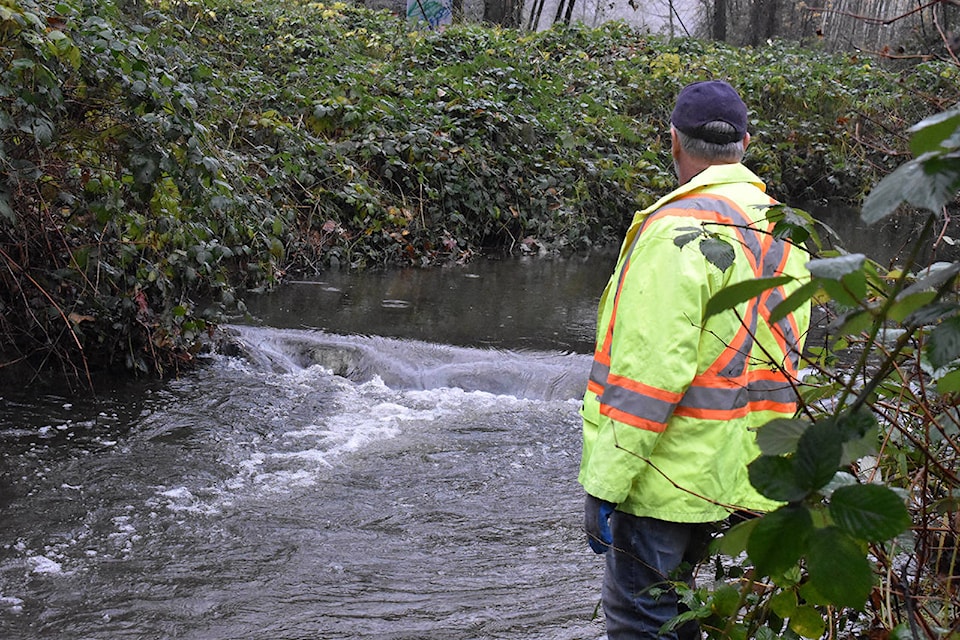Bob Scanlon is down at Cougar Creek four or five times a week. Like other members of the Cougar Creek Streamkeepers, he’s keeping an eye out for returning chum and coho salmon that should be spawning in North Delta waters.
But so far, he hasn’t seen very many.
Since the Streamkeepers first started keeping watch in mid-October, there have been about 20 sightings of returning salmon. Last year, they saw well over 100 by this time, and had a total return of 240 spawning salmon.
“It’s a little disappointing not to see fish here,” Scanlon said.
The streamkeepers weren’t expecting to see many fish spawning around the newly-created weirs in Lower Cougar Creek — that “was basically starting for next year,” Scanlon said — but even further up the creek, where the salmon traditionally spawn, there hasn’t been much activity.
And it’s not just Cougar Creek: the Nickomekl and Tynehead streamkeeping groups have also seen few returning salmon.
“It looks like it’s a bad year for everybody,” Scanlon said.
It is.
This year has seen low numbers for returning sockeye and pink, said salmon researcher Scott Hinch. Although it’s too early to tell exactly how many coho and chum will return to B.C. streams — those species spawn later in the year than pink or sockeye — he expects it to follow a similar pattern.
“We rely really heavily on hatcheries in the Lower Mainland for a lot of our returns of coho, and to a certain extent chum,” Hinch said.
“So when we see lots of hatchery fish going out and not a lot of fish coming back, that certainly speaks to habitat issues somewhere.”
Long-term trends of declining salmon stocks point to climate change as a key culprit ,with warmer waters creating less productive ecosystems in both coastal areas and the open ocean, where many salmon species like chum spend almost all of their life. Freshwater habitats also play an important role, especially for coho, which can spend half their lives in local streams.
But the record low returns for 2016 and 2017 can likely be attributed to what scientists call “the Blob” — a large mass of warm water that moved up the Pacific coast between 2013 and 2015.
Related: Dismal sockeye salmon run is Fraser River’s worst return in 120 years
“That probably laid the groundwork for some of the really poor, poor returns we’ve recently seen, because they wouldn’t have survived very well when water temperatures are so warm,” Hinch said. “Feeding conditions are poor, [and] it brings a whole new suite of predators.”
With the Blob now dissipated, Hinch is cautiously optimistic that future runs may see more returning fish.
“I always hate to say that because it’s like forecasting the weather a year from now,” he said, “but certainly we’re hopeful that the conditions will be somewhat better for fish returning next year.”
In the long run, however, there’s no way to know how the salmon will fare.
“These events like the Blob came out of nowhere and persisted for several years. What caused that, and how often that sort of thing may reoccur in the future is hard to predict,” Hinch said. “And it’s those sort of ocean uncertainties that drive the uncertainties in our returns.”
For Cougar Creek, which only sees a few hundred salmon return every year, a small number of spawners will have huge impacts for returning fish four years down the road.
“Places that get 10,000 or 15,000 fish, if they only get back eight [thousand], they still have a lot of fish,” Scanlon said. “But when you get 200 and you only get 30 back, that’s a major loss.”
grace.kennedy@northdeltareporter.com
Like us on Facebook and follow us on Twitter
